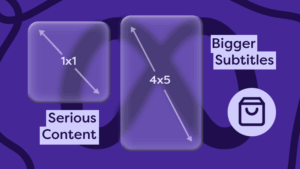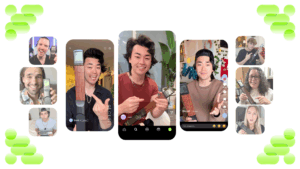Meta Ads Best Practices: What Actually Works in 2025 (and Why)
I lead the paid marketing team at Billo, focusing on performance, testing, and growth that scales.Over the past 6 years, I’ve worked across digital marketing - from running campaigns to building the strategies and systems behind them.What drives me is problem-solving. I like turning complex questions into simple, testable answers, and making decisions that actually drive impact.

Meta continues to dominate in paid social, especially for e-commerce and DTC brands. It is thanks to its deep attribution models and unmatched conversion tools. Unlike TikTok’s trend-first energy, Meta thrives on structure: precise targeting, robust tracking, and long-lasting ad performance.
In 2025, Meta’s algorithm now leans heavily on creative quality, not just spend. A 2025 AppsFlyer report found that 70–80% of Meta ad performance stems from how strong the creative is – not budget or targeting.
This blog distills Meta ads best practices based entirely on Billo’s internal research and creative testing – pulling from real campaign data to reveal what actually works. Whether you’re optimizing for performance or scaling creative, this guide delivers what matters now.
TL;DR
- Use 4:5 vertical format for Feed and Story dominance.
- Stick to serious tone—interviews and drama hooks outperform playful formats.
- Bold captions and graphic CTAs boost silent-view retention and clicks.
- Product PNGs and magnifying effects drive visual engagement.
- Iterate weekly; small changes to scripts or visuals yield big lifts.
Meta vs TikTok – Platform Behavior and User Intent
Meta and TikTok serve fundamentally different roles in the paid social funnel, our internal research confirms that these differences shape how creatives should be built and optimized.
TikTok leans into trend-driven discovery, favoring fast creative turnover. Videos often burn out within 1-2 weeks, making it ideal for top-of-funnel awareness but harder to sustain ROAS over time.
In contrast, Meta ads offer steadier returns, particularly for ecommerce and DTC brands. With stronger retargeting and conversion tracking, Meta supports mid-to-bottom funnel objectives much more effectively.
Audience behavior also differs. TikTok attracts younger, browsing-centric users, while Meta’s broader age range and higher purchase intent give advertisers a more conversion-ready audience. That’s why Meta is a go-to for brands in beauty, apps, and consumer goods looking to scale performance, not just visibility. For more, see Billo’s TikTok vs Facebook Ads breakdown and this guide to TikTok ad strategy.
Brands that treat Meta and TikTok the same risk underperforming on both. Understanding user behavior by platform is key to crafting creatives that convert.
Let’s dive into the Meta ads best practices to see how your creatives can win.
Explore the changes of Meta Andromeda update.
Importance of Format, Tone, and Placement for Meta
Winning on Meta isn’t just about having a great product – it’s about choosing the right format, tone, and placement to meet the platform’s performance standards. Billo’s internal creative analysis reveals that certain choices consistently drive stronger engagement and ROAS.
Meta formats like 4:5 vertical and 1:1 square perform best, especially in Feed and Stories placements. Unlike TikTok’s vertical-only layout, Meta supports multiple aspect ratios—giving brands more flexibility and testing surface. Billo testing shows 4:5 performs up to 15% better in Feeds than square videos, making it the go-to layout for most campaigns.
Tone also plays a pivotal role. On Meta, a more structured and serious approach – think drama-led scripts and interview formats. They tend to outperform casual, trend-based storytelling. Billo campaigns show that this format drives deeper engagement and longer watch times, particularly in ecommerce and beauty.
Placement matters too. The most effective campaigns tailor visuals per format (Feed, Reels, Stories, and Messenger) to ensure consistency across Meta’s ecosystem. Visuals are often enhanced with bold captions, graphic CTAs, and high-contrast elements. See how this plays out in Billo’s TikTok video ad creative guide and their breakdown on scaling Facebook Ads.
Creative Formats That Perform
Not all ad formats are created equal and Billo’s creative testing on Meta proves that small design decisions can drive big performance gains. From aspect ratios to layout choices, these are the Meta ads best practices shaping winning campaigns in 2025.

1. Use 4:5 and 1:1 for More Engagement
Billo data confirms that the 4:5 vertical crop outperforms 1:1 square in Feed placements by up to 15% – more screen space equals more attention. Vertical-first design also integrates better across Stories and Reels, where immersive viewing is key. That’s why a 4:5 format is the default starting point in Meta-focused campaigns and video creative strategies.
2. Leverage Split Screens and Poster Layouts
Split-screen formats, like product on one side, tutorial on the other, improve recall and keep viewers engaged. Billo testing shows up to 12% better memory retention in apps and consumer goods verticals using this format. Meanwhile, poster videos (a mix of still frames and short clips) lift watch times by ~18% in beauty and fashion, offering a scroll-stopping visual rhythm.
3. Bold Captions and Product PNGs Drive Results
Captions aren’t optional on Meta—they’re performance levers. Billo recommends large black-on-white subtitles to increase retention when videos play silently. And “pop-in” product PNGs during hook moments especially zoomed shots of ingredients or features boost brand recall by ~10%. For a breakdown of how to apply these tactics, check out Billo’s guide to scaling Facebook Ads.
Scripting & Storytelling on Meta
In a platform where creative quality drives most of the outcome, how you script your Meta ads matters as much as what you show. Billo’s internal testing highlights repeatable storytelling patterns that deliver stronger hook rates, watch times, and conversions.

4. Hook Tactics that Grab Attention
High-performing Meta creatives often start with masking effects visually obscuring and then revealing a product feature to build curiosity. In the beauty and lifestyle categories, these drive stronger hook retention. Another winning tactic? Notification bar graphics or simulated search bars that mimic native experiences. These stop the scroll by feeling familiar and relatable, especially in app and DTC ads.
5. Use Drama Set-Ups and Interview Scripts
Structured storytelling works. Billo research shows that “drama set-up” scripts, presenting a relatable problem, then resolving it with the product, consistently outperform generic formats. This approach works especially well for app ads where a clear solution narrative is critical.
Another effective structure is the interview-style video: think testimonials or founder Q&As. These mimic social proof and outperform traditional VO-led ads in skincare, fitness, and wellness categories. For more examples, see Billo’s top TikTok video ad guide.
6. Tone Matters: Inform Over Entertain
While TikTok rewards casual, humor-led storytelling, Meta calls for a more serious and structured tone. Informative, problem-solving narratives drive stronger conversions. Billo testing confirms that audiences in wellness, finance, and tech verticals respond better to clarity and credibility than to jokes or trends.
Design & CTA Optimization
Even strong scripts can underperform without smart visual design. On Meta, attention is won (or lost) in milliseconds – so CTAs, animations, and branding need to do more than look good. Billo’s research identifies the visual triggers that consistently drive conversions.

7. Use Graphic CTAs and End Cards
Great Meta ads don’t end without direction. Billo recommends finishing videos with graphic end cards that display the brand logo, URL, and a bold CTA. In beauty and wellness campaigns, this structure lifts brand recall and nudges post-view action. Color-blocking also helps these elements stand out against feed clutter, reducing blend-in and increasing interaction. For real-world examples, explore Billo’s Facebook ad optimization guide.
8. Highlight with Motion: Magnifying Effects Work
Billo-tested ads often include magnifying glass animations to emphasize product features, especially in skincare, wellness, and supplements. This directs focus and builds perceived value. Similarly, highlight animations (like glow or bounce effects on buttons or pricing) signal interactivity and subtly guide user behavior.
9. Use Branded Overlays and UI Cues
In beauty ads, Billo inserts mid-video PNG overlays of products or ingredients to anchor brand identity. These static frames reinforce recognition and make the content feel branded without being disruptive. In app ads, screenshot sequences or UI mockups serve a similar purpose adding utility while staying native to Meta’s feed. See how this plays out in Billo’s TikTok video ad design strategies and e-commerce ad tests.
Iteration and Testing
On Meta, top-performing brands don’t launch perfect ads – they build them through iteration. Billo’s creative performance engine reveals that frequent, data-driven testing consistently outpaces one-off campaigns, especially in high-velocity categories like beauty and e-commerce.

10. Beauty Brands Iterate Weekly
In the beauty vertical, Billo data shows that brands iterate creatives every 7-10 days, testing 3-5 visual variations per product ad. These changes range from layout tweaks to revised CTAs or pacing adjustments. Because Meta ads fatigue slower than TikTok’s, this cycle gives brands more testing runway without constant reinvention.
11. Test Micro-Variants, Not Entire Ads
Instead of overhauling the entire asset, Billo recommends micro-variant testing: changing caption copy, CTA design, or visual framing. Small edits often deliver 10-15% lifts in CTR and conversion, while preserving the creative’s core structure. This is especially effective when testing across placements like Reels versus Feed.
12. Use AI Voices and Avatars for Scalable Testing
Billo also leverages AI voiceovers and avatars to accelerate creative production. These tools maintain consistent tone and pacing, allowing brands to scale ad variants fast without sacrificing quality. They’re particularly useful in tutorial-style and how-to videos in beauty, wellness, and apps.
So what? Iteration isn’t just about testing what works – it’s about building a repeatable system to scale it, fast.
Looking to get more insight on how your ads perform? Explore Billo’s Performance Hub.
Summary: Creative Wins on Meta Start with Data
Billo’s research confirms what performance marketers already suspect – Meta ads best practices in 2025 are built on structure, not spontaneity. Unlike TikTok’s fast-burn trends, Meta rewards brands that get the fundamentals right: vertical layouts, bold captions, drama-led scripts, and graphic CTAs.
If you’re running ads in beauty, wellness, apps, or e-commerce, your best move isn’t more spend – it’s more variation. Test often. Lean into AI voiceovers. And use creators who’ve been proven to perform.
Want scroll-stopping Meta ads that convert? Scale creative the smart way with Billo.
What’s the best Meta ad format for ecommerce?
Billo data shows that 4:5 vertical video performs best—especially when paired with product PNG overlays, bold black-on-white captions, and graphic CTAs. These elements improve engagement and drive more conversions in ecommerce campaigns.
Should Meta video ads include captions?
Yes. Billo testing found that large, high-contrast captions significantly improve retention—especially when videos autoplay silently. This boosts ad recall across all age groups.
How often should I iterate creative on Meta?
For beauty and consumer products, iterate weekly. Test new hooks, visuals, and captions every 7–10 days while keeping your core structure constant.
What’s the difference between Meta and TikTok ad scripts?
TikTok favors casual, trend-driven storytelling. Meta performs better with structured scripts like interviews or drama-led problem-solution narratives.
Paid Marketing Lead
I lead the paid marketing team at Billo, focusing on performance, testing, and growth that scales.Over the past 6 years, I’ve worked across digital marketing - from running campaigns to building the strategies and systems behind them.What drives me is problem-solving. I like turning complex questions into simple, testable answers, and making decisions that actually drive impact.

Authentic creator videos, powered by real performance data
22,000+ brands use Billo to turn UGC into high-ROAS video ads.
Meta Andromeda Update Explained: Creative Volume...
Meta Andromeda update marks a major shift in how ads [...]...
Read full articleFrom Barbie to Duolingo: Social Media Marketing ...
Inspiring social media marketing campaigns help marketers push beyond performance metrics and [...]...
Read full articleInside the Campaigns: How Brands Win with Creato...
Creator-led advertising is no longer experimental. It reliably outperforms traditional [...]...
Read full article



